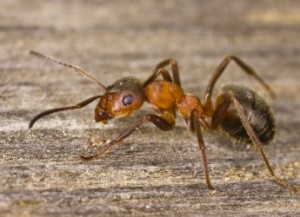It’s certainly no secret that ants lead a busy life. From foraging to fighting off predators, knowing how to navigate is very important for these tiny insects. Researchers Joseph L Woodgate, Cornelia Buehlmann, and Thomas S. Collett of the University of Sussex, sought to understand how wood ants (Formica rufa) used their visual surroundings to navigate.
Although numerous studies have indicated that ants use visual information from their surroundings to guide their movement, there has been less research examining what visual cues the ants are using. To investigate this, the researchers of this study conducted experiments in which wood ants would navigate to a food source guided by a single shape in an otherwise bare panorama. The ants movements were tracked by a video camera
Their results showed that when ants learned to move towards a point in a scene that was outside the shape, they quid themselves by holding the center of mass of the shaper in the appropriate position on their retina. They found these ants used centre of mass information they determine from scanning their field of vision to help them navigate to the food source. Ants learn the relative areas of the shape that lie to the left and right when facing the goal and then they set their path by keeping the proportions at the memorized value.
This ability to identify and utilize the panoramic visual information of an environment allows ants to correctly navigate. Although these findings help us better understand ants navigation mechanisms, the researchers suggest more investigation is needed to further understand how ants navigate complex panoramas rather than single shape panorama environments.
Source
Woodgate, J. L., Buehlmann, C., & Collett, T. S. (2016). When navigating wood ants use a shape’s centre of mass to extract directional information from a panoramic skyline. Journal of Experimental Biology, jeb-136697.

